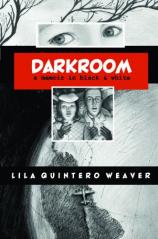Color Blind: Darkroom’s Past and Present
In the early 1960s, Lila Quintero Weaver’s family moved to the very small southern town of Marion. While they were Hispanic, their skin tones were “different” enough that they saw racism rear its ugly head. We talked to the author about her deeply personal memoir.
How long did you spend working onDarkroom?
Darkroom sprang from an academic project I did in 2007 as part of my studies at the University of Alabama. At that point, it was 40 pages long and only skimmed the surface of the subject matter. Editors from the University of Alabama Press saw an exhibit based on the project and approached me about publishing. This possibility had never crossed my mind, but I snapped up the opportunity and spent the next four years developing the initial material into long form.
Are you glad you waited this long to tell this story? Did it give you a perspective or historical sense that would have been lacking if you had done it earlier?
Yes to both questions. Memoirists need long perspective to figure out what's worth telling and how to tell it.
For too long, I was woefully ignorant about the historical era that I lived through. In my early schooling, I learned zero about the Civil Rights movement and next to nothing about immigration issues. I needed a reeducation, and this occurred in my late forties when I went back to finish my undergraduate degree. Among other things, I finally learned the historical significance of the violence that occurred just one block from my childhood home.
What was the most difficult part of the story to “relive” at this point?
Without question, the high school years. Like most teens, I was terribly self-absorbed and unhappy with how I looked and who I was. Lo, these many decades later, it was surprisingly uncomfortable to wade back into that period. I overcame my reluctance by meeting it head on. For example, I purposefully drew my seventh-grade character as ugly as I felt myself to be. I also had to fight the urge to spare myself the exposure of certain episodes. At fourteen, I became the target of intense gossip and I almost left this episode out of the book, because of how it fired up the pain. But it said so much about the racist climate of a small southern town that I finally concluded I couldn't leave it out. Amazingly, peeling off those layers of self-protection did me a world of good—one of the fringe benefits of memoir writing.
Were you surprised by some of the memories that came up while you were working on the book?
I first wrote an all-text version that I later developed into two levels of fully illustrated drafts. That process took me two years, and I thought I knew my subject matter thoroughly. But the final drawings required deeper research and that often led to newly recovered memories. Historical research helped, documentary film was invaluable, and so were newspapers of the period, which gave me jolting reminders of how overtly racism was expressed then and with so little push-back from a disapproving society.
Why did you want to tell this story in graphic novel form rather than the all-text version?
Persepolis was the first memoir in graphic novel that I encountered. It was a jaw-dropper, period. It also presented me with a possibility that I had never dreamed existed. Here was an adult woman telling her life story in a form tailor-made to my abilities. This was exciting all on its own.
You have to consider the publishing angle, too. As a Latino in the 1960s South, I represented a view of the Civil Rights years that hadn't received much focus. Even so, it's doubtful that my story would've attracted attention without the added value of hand-drawn illustrations.
Tell us a little bit about your background as an artist. What are some of the other things you’ve done before doingDarkroom?
I'm mostly self- and family-taught. My parents lavished my siblings and me with art supplies and informal instruction. We had no television and there was little money for expensive toys, so we drew for fun. My late mother was a trained artist who enjoyed modest success as a portrait painter. I learned a lot by watching her work. Eventually, I dabbled in portraiture too, but without enjoying it much. I also took commission work for logo designs, gallery paintings, decorative painting (such as murals and faux-finishing), and calligraphy—including addressing tons of wedding invitations. It was mostly tedious, client-driven work, but every bit of it fed the learning process.
I really love the look and tone of Darkroom—the art is beautifully rendered. How did you achieve the feel you wanted for the book?
Thank you! If I work hard at setting up a drawing, I position myself to make the final execution a matter of play. What a difference between a drawing that feels like grunt work and one that feels like floating. I wish I could say I reached that ecstatic plane for all 500 images in the book, but no. Sometimes I was carried along by nothing but the urgency to finish.
Technically speaking, I approached the art through the restriction of a grayscale palette. Pencil drawing is what comes most naturally to me, and it's a perfect medium for rendering form. It's highly tactile. You can manipulate gradations to simulate the dimensionality of objects. I used black ink in nearly every panel and gouache in a few. And let's not forget the eraser, which is also a drawing tool. I scanned my finished drawings at high resolution and then placed them into page layouts through Adobe Creative Suite InDesign. This allowed me to introduce layering, a form of digital collage that strongly appeals to my sense of aesthetics.
Do you plan to do more graphic novels in the future? More memoirs or fiction?
There's no memoir left in me, that's for sure.
I am considering how my visual style could serve fiction. Ideas come easily, but as you know, graphic novels are marathon events; you have to feel passionate about your project or you'll collapse from the sheer length of the run. There are plenty of graphic novelists that have taken the challenge repeatedly. They inspire me and so does the wonderful response that Darkroom has received, much of it from readers who had no previous exposure to the graphic novel. How could I stop now?




